
HOME
INTRO
SYMBOLS
ALMANAC
ECONOMY
GEOGRAPHY
STATE MAPS
PEOPLE
FORUM
NEWS
COOL SCHOOLS
STATE QUIZ
STATE LINKS
BOOK STORE
MARKETPLACE
GUESTBOOK
CONTACT US


You may double left-click on a word on this page to retrieve its definition. Tweet Follow
Washington State Dance
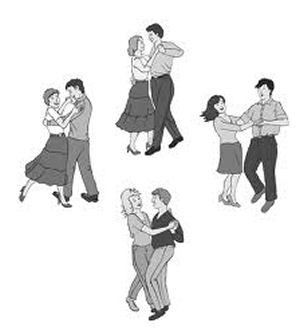
Washington State Dance: Square Dance
In the late 1970s, as modern western-style square dance clubs met defeat after defeat in their efforts to name the square dance the national folk dance of the United States of America, their efforts focused on passing legislation at the state level. The intention was to get each state to designate the square dance as their official "state" folk dance. A major purpose of the state level activity was to fortify the case for a national folk dance. As activity on the national level continued, Oregon became the first state to adopt, by Senate Concurrent Resolution, the square dance as its official dance (1977).
The next year a bill was pre-filed in the Washington State Legislature. Senate Bill No. 2015 (SB2015), by Senator Don Talley. SB2015 proposed the square dance as "the official state dance of the State of Washington." At this time, Talley stated that he filed the measure at the request of square dance clubs throughout the state to help publicize the National Square Dance Convention scheduled for the Seattle Center, Seattle in 1981.
In the House, a similar bill, House Bill No. 218 (HB218) was introduced by Representative W.H. Fuller.
SB2015 was scheduled to go before the Senate Parks and Recreation Committee on January 23, 1979, for its first step on the road to officialdom. Prior to the hearing,
About 200 dancers in western attire, some in wheelchairs, pranced around the Capitol rotunda for an hour, then packed Senate galleries for a committee hearing on the measure Wednesday night.
(Associated Press, "Solons prove they're no squares", p. 5)

Saturday Night Square Dancing (1942)
The Parks and Recreation Committee voted unanimously to recommend Senate Bill No. 2015 for adoption by the full Senate.
On March 21, 1979, the full Senate passed Senate Bill No. 2015 and the dance bill was forwarded to the House for consideration.
It did not languish long in the state House of Representatives. It was approved on April 9, 1979.
Only one more hurdle remained before the square dance would be adopted as the official state dance of Washington. The measure had to be approved, or at least not vetoed, by Governor Dixy Lee Ray. She was not an enthusiastic supporter of the bill, to say the least.
However, on April 19, 1979, the governor whooped "Do-si-do!" and did sign Senate Bill No. 2015 making the square dance the official state dance of the State of Washington.
After the signing, she had little to say.
"I can assure you I gave that particular bill about one microsecond of thought. That's about what I think it deserves. It would have only prolonged useless discussions to have vetoed it."
(Associated Press, "Ray signs square dance bill", p. 7)
CHAPTER 10
[Senate Bill No. 2015]
THE SQUARE DANCE--OFFICIAL STATE DANCEAN ACT Relating to the naming of a state dance; and adding a new section chapter to 1.20 RWC.
Be it enacted by the Legislature of the State of Washington:
NEW SECTION. Section 1. There is added to chapter 1.20 RWC a new section to read as follows:
The square dance is designated as the official state dance of the State of Washington.
At the time of the bill's passage, it was estimated that around 14,000 Washingtonians belonged to square dance clubs within the state.
At the federal level, the United States of America was still without an official state folk dance as 2015 came to an end. The latest effort seems to have failed with the introduction of House Resolution No. 645 (Promenade Act), by Representative Ed Whitefield of Kentucky, in 2003.
However, since Washington became the second state to adopt square dancing as its official state dance, a majority of the other states have taken the time to name square dancing as an official representative.

Traditional Square Dance Musicians
The square dance is a popular type of folk dance in the United States. This dance for four couples, or groups of four couples, is performed in a compact framework of a square, each couple forming a side. Traditionally accompanied by a fiddle, accordion, banjo and guitar, the couples perform a variety of movements prompted by the patter or singing calls (instruction) of a "caller". Cooperative movement is the hallmark of well-executed square dancing.
Square dancing is to be distinguished from related dances called contra or longways dance where couples stand double file in a line and from round dances where couples stand in a circle. The origin of the square dance can be traced to English derivation and to the stately French cotillion performed in square formation that was popular at the court of Louis the fifteenth later replace by the quadrille (another square dance).
According to the Washington Legislature:
"On April 17, 1979, the square dance became the official Washington state dance. When the pioneers came west, they brought with them a dance called the quadrille, which means square in French. The pioneers liked the simpler term and so the square dance was born. The dance is known for its series of figures and footwork. Dancers are directed by a caller. It is easy to learn, a good form of exercise and fun."
"Square Dance"
A brief description of the efforts to declare the square dance the national folk dance of the United States of America can be found here.
Washington Law
The following information is excerpted from the Revised Code of Washington, Title 1, Chapter 1.20, Section 1.20.073.
Title 1 - GENERAL PROVISIONS.
1.20 General provisions.
1.20.075 State dance.
RCW 1.20.075
State dance.
The square dance is designated as the official dance of the state of Washington.
[1979 ex.s. c 10 § 1.]
Sources...
Cooper, Dennis W., comp. "Chapter 10." 1979 Session Laws of the State of Washington 1st Extraordinary Session, Fourty-Sixth Legislature (1979): 1056. Washington General Assembly. State of Washington. Web. 6 Jan. 2016.
"Do-si-do - a State Dance Is in the Offing." Walla Walla Union-Bulletin 27 Dec. 1978: 24. Walla Walla Union-Bulletin. Web. 6 Jan. 2016.
Mangin, Julie. "The State Folk Dance Conspiracy: Fabricating a National Folk Dance." The Old Time Herald 1995, V.4(7), Spring 1995 ed.: 9-12. The Old Time Herald. Web. 18 Nov. 2004.
Shearer, Benjamin F. and Barbara S. State Names, Seals, Flags and Symbols: A Historical Guide Third Edition, Revised and Expanded. Westport, Conn: Greenwood Press, 3 Sub edition, 2001.
"Ray Signs Square Dance Bill." Walla Walla Union-Bulletin 18 Apr. 1979: 7. Walla Walla Union-Buletin. Web. 6 Jan. 2016.
"Solons Prove They're No Squares." Walla Walla Union-Bulletin 25 Jan. 1979: 5. Walla Walla Union-Bulletin. Web. 16 Jan. 2016.
"Square Dance." Washington General Assembly. State of Washington. Web. 12 Nov. 2004.
"Square Dance Legislation Collection, The." The American Folklife Center. The Library of Congress, 15 May 2015. Web. 18 Nov. 2004.
Additional Information
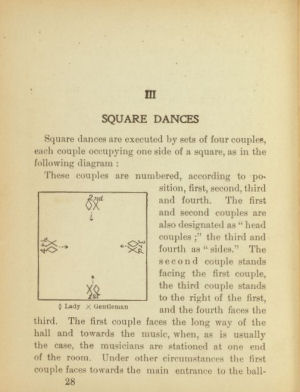
Washington State Dance: Square Dance
Square Dancing 101: Square dancing basic including positions, formations, moves, and a glossary.
Video Square Dance Lessons Online: Video Square Dance Lessons Online and on DVD from Cyberpoint Marketing, LLC.
A Brief History of Square and Round Dancing: by Herb Egender.
Square Dancing: The Historical Geography of an American Folk Custom: by Richard M. MacKinnon, Allan Hancock College, Santa Maria, California.
Square Dance History Project: Website devoted to the documenting the history of square dancing with historical documents and an emphasis on imagery as much as possible..
History and Heritage of Modern American Square Dancing: A summary of the essays by Dorothy Shaw, Bob Osgood and Kenny Reese.
The State Folk Dance Conspiracy: Fabricating a National Folk Dance: by Judy Mangin - Originally published in the Old-Time Herald, v.4(7) p.9-12, Spring 1995.
National Folk Dance Effort Moves Forward: We're On Our Way Now, So Let's Make a Lot of Noise!: United Square Dancers of America National Folk Dance Committee.
The Square Dance Legislation Collection: American Folklife Center 1984/024, Compiled by Michelle Forner, Library of Congress, Washington DC, December 1994
Square Dance in Washington: Website of the Square and Folk Dance Federation of Washington.
State dances: Complete list of official state dances from NETSTATE.COM
More symbols & emblems: Complete list of official Washington state symbols from NETSTATE.COM.
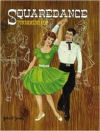
Square Dance Fundamentals
John W. Jones
Square Dance Fundamentals, John W. Jones. 208 pages. Publisher: BookSurge Publishing (February 5, 2007)
While there have been countless fun books written on square dancing, Squaredance Fundamentals was the first to cut to the chase. There is no interesting history of square dancing, there are no entertaining anecdotes, just the nuts and bolts of how to square dance. Revolutionary illustrations show the dancer’s point of view, not just the spectators’ viewpoint. Dancers can, without turning on their heads, glean from the detailed illustrations exactly what they need to be doing with their hands, feet, etc. Each dancer can effortlessly grasp the material and easily retain it. Renown master caller/teacher, Marshall Flippo, assiduously assisted the author in establishing the very first guidelines for standardized “Basic Maneuvers” which would enable square dancers to dance gracefully with any group, anywhere.
No one shows you better how to execute the maneuvers than John W. Jones with his super simplified instructions and state-of-the-art illustrations in Squaredance Fundamentals - the gold standard for over 37 years.
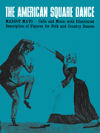
The American
Square Dance
Margot Mayo
The American Square Dance, by Margot Mayo. 116 pages. Publisher:Music Sales American (September 1, 2006)
You can have fun square dancing and you'll learn how to dance the figures and even learn how to call a square dance with Margot Mayo's classic manual, The American Square Dance. Here is the basic book for square dancers containing all of the essentials for many hours of enjoyment. An illustrated glossary of square dance terms shows all of the basic square dance figures – promenade, allemand, left, do-si-do, etc. Complete instructions, calls and illustrated figures for 13 of the most popular American square dances appear, plus the music all ready for your pianist and fiddlers to play.
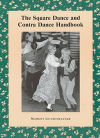
The Square Dance and
Contra Dance Handbook
Margot Gunzenhauser
The Square Dance and Contra Dance Handbook: Calls, Dance Movements, Music, Glossary, Bibliography, Discography, and Directories, by Margot Gunzenhauser. 320 pages. Publisher: McFarland & Company, Inc., Publishers; annotated edition edition (July 28, 2010)
This comprehensive guide to traditional style square and contra dancing, sometimes referred to as "country dancing," covers both music and style and gives background information on various dance types and calling techniques. Ninety dances, presented in chapters according to type (mixers, progressive circles, contra, Southern mountain style, squares and others), in a wide variety of formations are described with drawings and diagrams for many of the movements. A glossary of terms, a directory of addresses (organizations; vendors of books, recordings and audio equipment; and dance camps), and an annotated discography and bibliography are also provided.
A glossary of terms, a directory of addresses (organizations; vendors of books, recordings and audio equipment; and dance camps), and an annotated discography and bibliography are also provided.
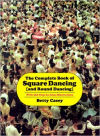
The Complete Book
of Square Dancing
(and Round Dancing)
Betty Casey
The Complete Book of Square Dancing (and Round Dancing), by Betty Casey. 208 pages. Publisher: University of North Texas Press (June 1, 2000)
This book includes: 50 basic movements, 35 advanced movements, variations, dances that are a part of the American heritage, Contra and Round Dances, polkas and reels, and calls, past and present.
“Square dancing is friendship set to music,” says author Betty Casey. Just take four couples, old or young, put ’em on a good floor, turn on the music, and you’re all set. Whether you’ve done it before or you’re just starting out, this book tells you everything you need to know—85 basic movements used all over the world, the spirited calls unique to square dancing, the costumes and equipment that are best, and music (from “Red River Valley” to “Mack the Knife”) that will set your feet in motion.
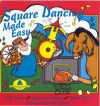
Square Dancing
Made Easy
Square Dancing Made Easy, Grade level: K-6. Audio CD (September 1, 1995), Number of Discs: 1, Label: Educational Activities, Inc.
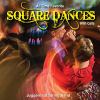
All Time Favorite
Square Dances
All Time Favorite Square Dances with Calls, Audio CD (September 8, 2009), Number of Discs: 1, Label: KADO, Run Time: 60 minutes.

Square Dance Music
& Calls
Square Dance Music & Calls, Audio CD (November 21, 2006), Number of Discs: 1, Label: Collectables Records.
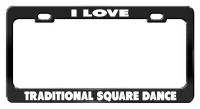
Black Metal
License Plate Frame
I LOVE TRADITIONAL SQUARE DANCE Black Metal Car Accessories License Plate Frame, This high quality license plate frame is made of metal, and it's the best quality item of its kind in the market. The lettering and art work are done by waterproof vinyl on the license plate frame and it will last for many years without any damage. It will not get brittle or cracked. It fits on all USA and Canada vehicles. It measures 12.5" X 6.5" and is durable to last under all weather conditions.
- Heavy Duty High Quality Metal License Plate Frame.
- Perfect Gift idea And Easy Installation.
- Rust, Corrode And Fade Free For Many Years.
- Fits all US and Canada License Plates.
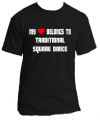
Traditional Square
Dance T-Shirt
MY HEART BELONGS TO TRADITIONAL SQUARE DANCE, This is a high quality pre-shrunk t-shirt that will not shrink or fade. It's comfortable, casual and loose fitting and will quickly become one of your favorites. It wears and looks well on anyone. It is cured with a heat treatment process to ensure lasting durability.
Brand New High quality preshrunk tee-shirt that will not shrink or fade. Double-needle stitched hemmed sleeves and bottom. Highest quality printing materials. 50% Cotton, 50% Polyester preshrunk blend. Soft, comfortable and weighs 6 oz.
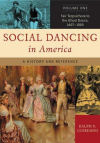
Social Dancing in America: A History and Reference (Volume One), by Ralph G. Giordano. 380 pages. Publisher: Greenwood (November 30, 2006)
Social Dancing in America examines the role of social dancing in daily life from the first settlements in 1607 through the birth of the nation in 1776 and into the beginning of the 21st century. This two-volume set provides a history of American social dances including the Virginia Reel, Square Dancing, the Lindy Hop, Rock 'n' Roll, the Twist, Disco, Breakdancing, and Hip-Hop. Social Dancing in America places social dancing in a historical, social, cultural, and political context.
Volume 1 explores the integral role that social dancing played in the lives of Americans from the first settlements in 1607 through the 19th century, often in the most unlikely of ways. For example, readers may be surprised to learn that George Washington was a well-known aficionado of social dancing, and that he incorporated the etiquette and manners of dances such as the Minuet as a means of diplomacy to secure European allies during the Revolutionary War. After his death, Americans continued to celebrate his birthday with a grand ball that included dancing.
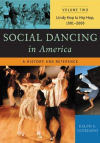
Social Dancing in America: A History and Reference (Volume Two), by Ralph G. Giordano. 428 pages. Publisher: Greenwood (November 30, 2006)
Volume 2 places social dance in a 20th-Century context, illustrating how social dancing itself paralled the social, economic, and cultural traditions of each era. For example, segregation and the Jim Crow mentality was cemented in place all over the United States, and for much of the century, dancing and dance halls were strictly segregated. Segregation forced a mass migration north, and with it came the transformation of Delta Blues music into an American original—Jazz. Jazz gave birth to the Charleston, and later evolved into Swing, which created the Lindy Hop. Later, with the advent of television, programming such as American Bandstand, Soul Train, Dance Fever, and MTV greatly influenced dance styles and modern trends such as Rock 'n' Roll, Freestyle, Disco, Breakdancing, and Hip-Hop.

